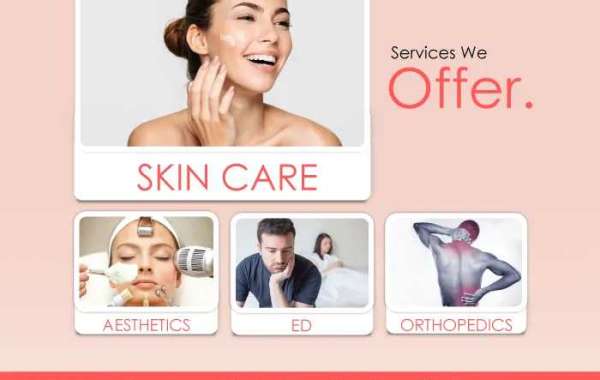In a world increasingly conscious of beauty standards, the desire for fairer skin remains prominent in many cultures. While the concept of skin whitening can be controversial due to its socio-cultural implications, it remains a significant market driven by personal preferences and societal pressures. This article delves into the efficacy and safety of various skin whitening products and whitening injection
treatments available today, offering a comprehensive guide for those considering such options.
Understanding Skin Pigmentation
Before exploring the treatments, it's essential to understand the science behind skin color. Skin pigmentation is primarily determined by melanin, a pigment produced by melanocytes in the skin. Genetic factors, sun exposure, hormonal changes, and certain medications can influence melanin production. Hyperpigmentation, characterized by dark patches on the skin, is often a target for skin whitening treatments.
Over-the-Counter Skin Whitening Products
1. Hydroquinone
Hydroquinone is a widely used ingredient in skin whitening products. It works by inhibiting the enzyme tyrosinase, which is crucial for melanin production. Products containing 2% hydroquinone are available over-the-counter, while higher concentrations require a prescription.
Effectiveness: Hydroquinone is considered effective for reducing hyperpigmentation and evening out skin tone. Studies have shown significant improvements in conditions like melasma and post-inflammatory hyperpigmentation.
Safety: While effective, hydroquinone can cause side effects such as skin irritation and, in rare cases, ochronosis (a bluish-black discoloration). Long-term use is not recommended, and it's banned in some countries due to safety concerns.
2. Kojic Acid
Kojic acid is a natural compound derived from fungi, often used in skincare products for its melanin-inhibiting properties. It's commonly found in creams, serums, and soaps.
Effectiveness: Kojic acid is effective for lightening dark spots and treating melasma. It also has antioxidant properties that benefit overall skin health.
Safety: Kojic acid can cause skin irritation, especially for those with sensitive skin. It's essential to use it in recommended concentrations and apply sunscreen, as it can increase sun sensitivity.
3. Vitamin C
Vitamin C, also known as ascorbic acid, is a powerful antioxidant that inhibits melanin production. It’s popular in serums and creams for its brightening and anti-aging benefits.
Effectiveness: Regular use of vitamin C can lead to a brighter complexion and reduced appearance of dark spots. It's particularly effective when combined with other skin-brightening agents.
Safety: Vitamin C is generally safe for most skin types but can cause mild irritation. It's crucial to store it properly, as it can degrade when exposed to light and air.
4. Niacinamide
Niacinamide, or vitamin B3, is a versatile skincare ingredient that offers various benefits, including skin brightening. It reduces the transfer of melanin to the skin's surface and improves overall skin barrier function.
Effectiveness: Studies have shown that niacinamide can effectively reduce hyperpigmentation and improve skin texture. It also has anti-inflammatory properties, making it suitable for sensitive skin.
Safety: Niacinamide is well-tolerated and safe for most skin types, with minimal side effects.
5. Alpha Arbutin
Alpha arbutin is a derivative of hydroquinone and is considered a safer alternative. It works by inhibiting tyrosinase activity, reducing melanin production.
Effectiveness: Alpha arbutin is effective in lightening dark spots and improving skin tone. It's often used in combination with other skin-brightening agents for enhanced results.
Safety: Alpha arbutin is generally safe and well-tolerated, with a lower risk of irritation compared to hydroquinone.
Professional Skin Whitening Treatments
1. Chemical Peels
Chemical peel involve applying a solution to the skin that exfoliates the top layers, promoting new skin growth. Peels can vary in strength from superficial to deep, depending on the type of acid used.
Effectiveness: Chemical peels can effectively treat hyperpigmentation, melasma, and sun damage. They also improve skin texture and tone.
Safety: Superficial peels have minimal downtime and side effects, while deeper peels require more recovery time and carry higher risks of complications like scarring and infection. It's crucial to have peels performed by a qualified professional.
2. Laser Treatments
Laser treatments use focused light energy to target and break down melanin in the skin. Popular options include Q-switched Nd
lasers and fractional lasers.
Effectiveness: Laser treatments can produce significant improvements in hyperpigmentation and overall skin brightness. They are particularly effective for stubborn pigmentation issues.
Safety: Laser treatments can cause temporary side effects like redness, swelling, and peeling. There's also a risk of post-inflammatory hyperpigmentation, especially in darker skin tones, so it's essential to choose an experienced practitioner.
3. Microdermabrasion
Microdermabrasion is a non-invasive procedure that exfoliates the skin using a device that sprays fine crystals or a diamond-tipped wand. It removes the outermost layer of dead skin cells, revealing fresher skin underneath.
Effectiveness: Microdermabrasion can improve the appearance of hyperpigmentation, fine lines, and acne scars. It offers immediate results with minimal downtime.
Safety: The procedure is generally safe, with mild and temporary side effects like redness and sensitivity. It's suitable for all skin types.
4. Cryotherapy
Cryotherapy involves applying extreme cold to targeted areas of the skin using liquid nitrogen. This treatment can destroy hyperpigmented cells and promote the growth of new, lighter skin.
Effectiveness: Cryotherapy can effectively reduce localized hyperpigmentation and sunspots. It’s a quick procedure with visible results.
Safety: Common side effects include redness, swelling, and blistering. There’s also a risk of hypopigmentation (lightening of the treated area) and scarring.
5. Prescription Topicals
Dermatologists may prescribe stronger topical treatments for stubborn hyperpigmentation. These can include higher concentrations of hydroquinone, retinoids (like tretinoin), and corticosteroids.
Effectiveness: Prescription topicals are often more potent and effective than over-the-counter options. They can significantly reduce hyperpigmentation when used as directed.
Safety: These treatments can cause side effects like irritation, redness, and peeling. It's important to follow the dermatologist's instructions and use sunscreen to protect the skin.
Natural Remedies for Skin Whitening
1. Licorice Extract
Licorice extract contains glabridin, a compound that inhibits tyrosinase activity. It's a common ingredient in natural skin brightening products.
Effectiveness: Licorice extract can reduce hyperpigmentation and lighten dark spots over time. It's also soothing and anti-inflammatory.
Safety: Licorice extract is generally safe for most skin types, with a low risk of irritation.
2. Aloe Vera
Aloe vera contains aloin, a compound with skin-lightening properties. It's also hydrating and soothing, making it a popular ingredient in skincare.
Effectiveness: Aloe vera can help lighten dark spots and improve overall skin tone with regular use. It also promotes skin healing and hydration.
Safety: Aloe vera is safe for most skin types, but it's essential to use pure aloe vera gel to avoid irritation from added ingredients.
3. Green Tea Extract
Green tea extract is rich in antioxidants, particularly epigallocatechin gallate (EGCG), which has skin-lightening properties. It can inhibit melanin production and protect the skin from UV damage.
Effectiveness: Green tea extract can help reduce hyperpigmentation and improve skin tone over time. Its antioxidant properties also provide anti-aging benefits.
Safety: Green tea extract is safe for most skin types and is unlikely to cause irritation.
4. Papaya
Papaya contains the enzyme papain, which can exfoliate the skin and promote cell turnover. It also has vitamin C, which can brighten the skin.
Effectiveness: Regular use of papaya-based masks or products can help lighten dark spots and improve skin texture. It is particularly effective for mild pigmentation issues.
Safety: Papaya is generally safe, but some people might experience mild irritation or allergic reactions.
5. Turmeric
Turmeric contains curcumin, a compound with anti-inflammatory and antioxidant properties. It has been traditionally used for its skin-lightening and healing benefits.
Effectiveness: Turmeric can help reduce the appearance of dark spots and even out skin tone. It also has anti-inflammatory benefits that can soothe the skin.
Safety: While turmeric is generally safe, it can stain the skin temporarily and cause mild irritation in some individuals. Patch testing is recommended.
Lifestyle and Preventive Measures
1. Sun Protection
Exposure to UV rays is a significant factor in skin pigmentation. Using broad-spectrum sunscreen with at least SPF 30, wearing protective clothing, and avoiding peak sun hours can prevent hyperpigmentation and protect against skin damage.
Effectiveness: Consistent use of sunscreen is highly effective in preventing new pigmentation and protecting the results of skin whitening treatments.
Safety: Sunscreen is safe for daily use and is essential for all skin types.
2. Healthy Diet
A diet rich in antioxidants, vitamins, and minerals can support overall skin health. Foods high in vitamin C, E, and beta-carotene can promote a brighter complexion and protect against oxidative stress.
Effectiveness: A healthy diet can improve skin appearance and complement the effects of topical treatments.
Safety: Eating a balanced diet is safe and beneficial for overall health.
3. Hydration
Keeping the skin well-hydrated is crucial for maintaining a healthy complexion. Drinking plenty of water and using moisturizers can help keep the skin plump and reduce the appearance of dark spots.
Effectiveness: Hydration supports skin health and can enhance the effectiveness of other skin whitening treatments.
Safety: Hydration is safe and essential for overall well-being.
Combining Treatments for Optimal Results
Combining different treatments and products can often yield better results than using a single method. For example, using a combination of topical treatments like vitamin C and niacinamide can enhance skin brightening effects. Similarly, professional treatments like chemical peels or laser therapy can be complemented by at-home skincare routines to maintain and prolong results.
Personalized Approach
It’s essential to recognize that skin whitening treatments are not one-size-fits-all. Factors such as skin type, the severity of hyperpigmentation, and individual sensitivities must be considered when choosing a treatment plan. Consulting with a dermatologist can help tailor a personalized approach that maximizes effectiveness while minimizing potential side effects.
Monitoring and Adjusting
Regular monitoring of the skin’s response to treatments is crucial. Adjustments may be necessary based on the skin's reaction and the progress achieved. A dermatologist can provide guidance on how to adapt the treatment regimen for optimal results.
Ethical Considerations and Mental Health
Societal Pressures
The desire for fairer skin often stems from deep-rooted societal pressures and beauty standards. It's important to reflect on these influences and consider the reasons behind seeking skin whitening treatments.
Mental Health Impact
While improving skin appearance can boost confidence, it’s essential to approach skin whitening with a healthy mindset. Unrealistic expectations or an obsession with achieving a certain skin tone can negatively impact mental health. Emphasizing self-acceptance and embracing one’s natural skin color is equally important.
Informed Decision-Making
Making informed decisions about skin whitening treatments involves understanding both the benefits and risks. Consulting with healthcare professionals, researching products and treatments, and considering long-term effects are crucial steps in this process.
Conclusion
Skin whitening treatments and products offer various options for those seeking to lighten their skin or address hyperpigmentation. From over-the-counter products like hydroquinone and vitamin C to professional treatments like chemical peels and laser therapy, there are multiple avenues to explore. Natural remedies and preventive measures can also play a supportive role in achieving and maintaining a brighter complexion.
Ultimately, the effectiveness and safety of skin whitening treatments depend on individual skin types, the severity of pigmentation, and proper usage. Consulting with dermatologists and adopting a personalized approach can help achieve the desired results while minimizing risks. Moreover, it’s vital to reflect on the motivations behind seeking skin whitening and prioritize mental health and self-acceptance in the journey towards achieving healthy, radiant skin.








